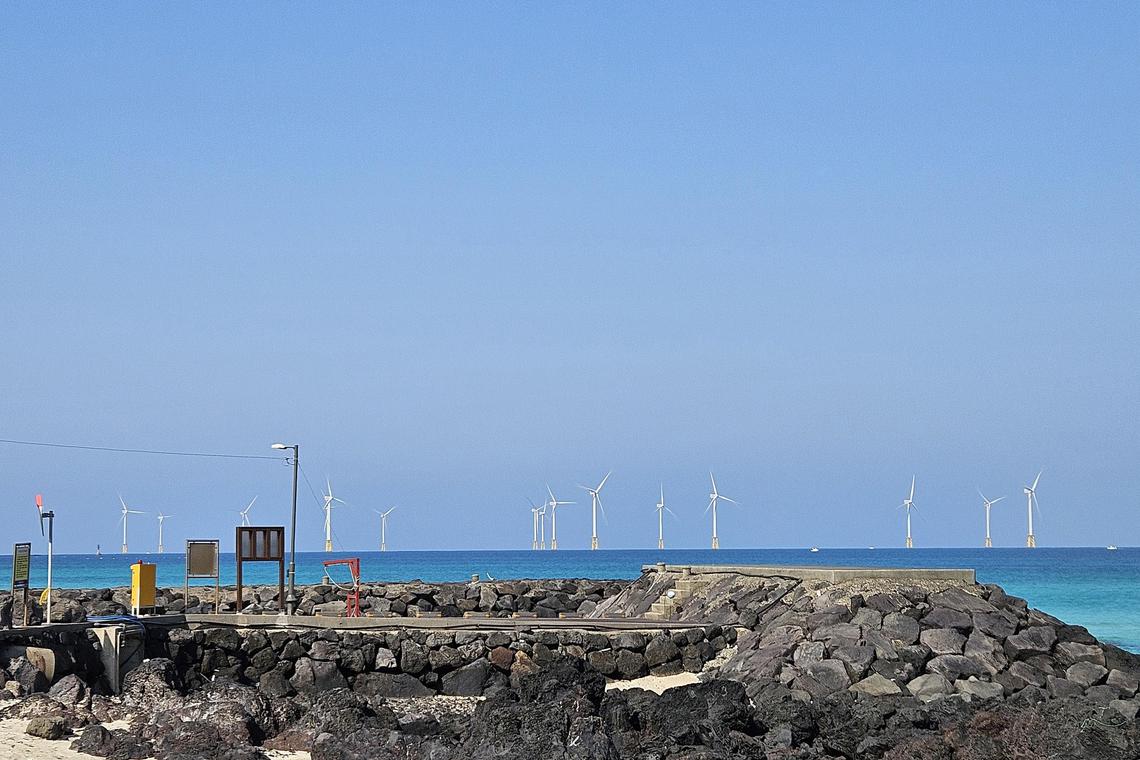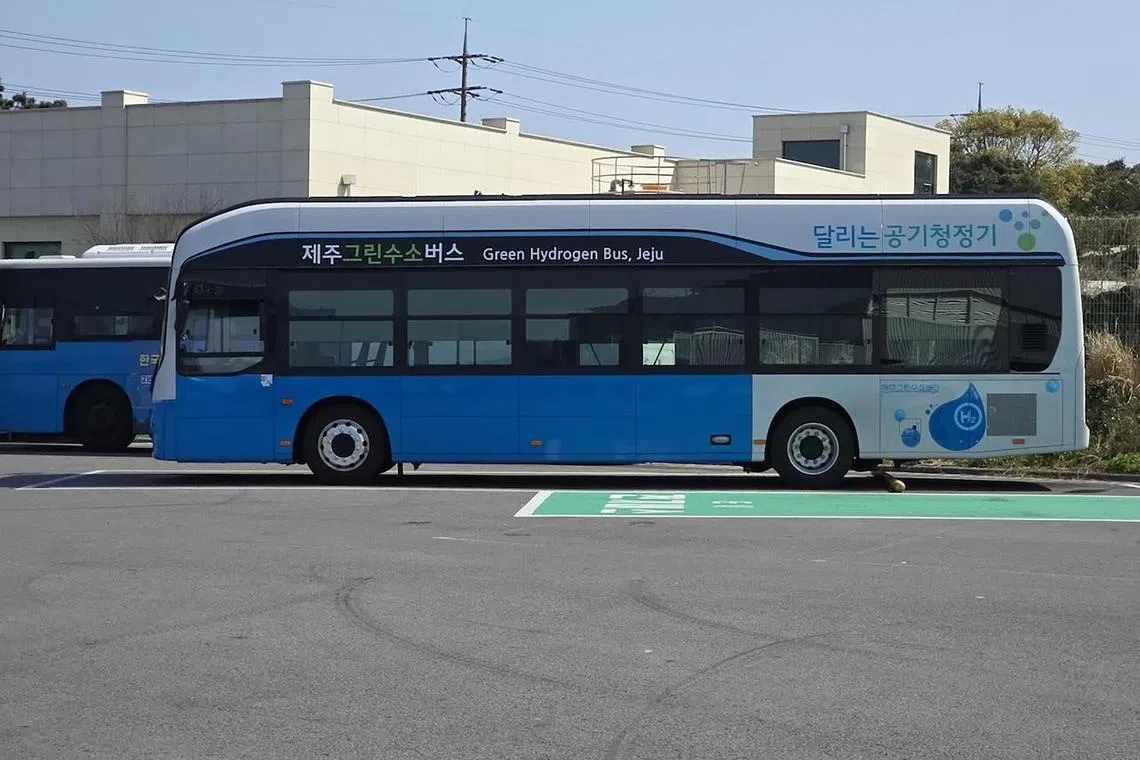Powering past tourism: Jeju island bets on green hydrogen tech. Will it pay off?
Sign up now: Get ST's newsletters delivered to your inbox

A Hyundai Nexo hydrogen fuel cell car as seen at Hamdeok Green Hydrogen Station.
ST PHOTO: ALBERT WAI
Follow topic:
JEJU – From a distance, the Hamdeok Green Hydrogen Station looks just like any other petrol station.
But instead of the bulky pump nozzle, a more slender fuel nozzle pipes compressed green hydrogen into a vehicle.
It takes around six minutes to refuel a Hyundai hydrogen fuel cell electric car at Hamdeok on Jeju island, the first refuelling station to offer commercial sale of green hydrogen in South Korea.
With 6kg of hydrogen on board, a car can travel for around 600km, rivalling the latest electric vehicle (EV) battery technology in terms of ultra-fast charging times and driving range.
The volcanic island of Jeju is well known for tourism, drawing more than 11 million visitors per year. But it is gearing up for a different kind of future as it positions itself as a test bed for green hydrogen energy while striving for carbon neutrality by 2035, well before the national target of 2050.
As part of the journey, the island wants to increase its renewable energy generation rate to at least 70 per cent.
Analysts interviewed by The Straits Times note that there are challenges in scaling up renewable hydrogen adoption, such as production costs and storage. But they are hopeful that costs can be lowered with further innovation.
“Economies of scale, learning rates, increased policy support and development of wider energy infrastructure will bring down production costs,” said Dr Thomas Koller, who oversees hydrogen, ammonia, sustainable fuel and carbon capture issues for energy systems in the Asia-Pacific region at risk management firm DNV.
“Costs of renewable hydrogen produced by electrolysis will fall with innovation as well as with larger production modules being manufactured,” he added.
The subtropical island, with a population of about 700,000 people, enjoys advantages in harnessing renewable energy, especially via wind and solar. However, limitations in these existing technologies mean that Jeju has to explore green hydrogen as an option to better utilise the power generated.
The province has more than 100 wind turbines, both onshore and offshore.

The Hallim wind farm, off the north-west coast of Jeju, is South Korea’s largest offshore wind project.
ST PHOTO: ALBERT WAI
The Hallim wind farm, which is off the island’s north-west coast, is South Korea’s largest offshore wind project. Completed in 2024, it has 18 turbines that can produce 100MW of clean electricity. Kepco Australia, a subsidiary of state-owned enterprise Korea Electric Power, says this would be enough to power approximately 65,000 households per year.
According to national investment promotion agency Invest Korea, wind and solar installations in Jeju are able to generate more than 500 MW.
Already, Jeju is ahead of other provinces in transitioning to renewable energy. Its renewable energy generation rate stands at around 20 per cent of its total power generation, the highest among all the provinces. The national figure is around 10 per cent.
While wind and solar energy sources are abundant, renewable electricity generation would be forced to shut down at times of high power output to prevent the grid from being overloaded. This has been a problem for Jeju.
The local authorities are therefore trying to make better use of surplus energy generated during periods of non-peak demand.

Jeju Governor Oh Young-hun speaks to visiting foreign journalists on April 2.
ST PHOTO: ALBERT WAI
Jeju Governor Oh Young-hun told visiting journalists in April: “Peak energy consumption hours for us are at night, when local people come home from work and when tourists go back to their accommodation after touring.
“How do we strike a balance between demand and supply? So we are going to utilise the surplus energy generated (via renewables) to be stored as green hydrogen.”
In Singapore, where a national hydrogen strategy was launched in 2022, hydrogen has been described as a low-carbon fuel that could meet 50 per cent of the country’s power needs by 2050.
While hydrogen energy can be produced from various sources such as natural gas, green hydrogen is made using renewable electricity to split water molecules into hydrogen and oxygen through a process called electrolysis. The latter emits no carbon emissions during production.
There are four main electrolysis methods used in green hydrogen production.
“We are trying to find out which is the most economically viable among them,” said Mr Yang Je-yun, the director-general of Jeju’s Innovative Industry Bureau.
“Through this (3.3MW) demonstration project, we can say with confidence that we can achieve economies of scale sooner or later. We will provide cheaper green hydrogen for consumers going forward.”
A 3.3MW hydrogen production facility has been built at a cost of US$14 million (S$18.2 million), funded by central government subsidies and the private sector. It produces 600kg of green hydrogen per day, which is supplied to Hamdeok station. The green hydrogen is transported via specialised trailers that ensure safety.
There is also a 2 MW-hour battery energy storage system to ensure stable operations, and the plan is to expand Jeju’s green hydrogen capacity to 30MW by 2030.
Mr Wisarut Larsakul, a Korean studies researcher at Chulalongkorn University in Bangkok, noted that Jeju has achieved great success by using tourism as a status symbol. “But this can no longer elevate the region any further. Jeju is now aiming for a new kind of status symbol – one rooted in science and technology development,” he said.
Currently, the number of hydrogen vehicles in Jeju is small – there are about 60 of them, including buses and passenger cars.

A bus powered by green hydrogen in Jeju island, South Korea. The province is striving for carbon neutrality by 2035.
PHOTO: COURTESY OF SAO PHAL NISIEY
To help defray the higher vehicle and fuel costs, those who buy hydrogen fuel cell cars in Jeju will be eligible for subsidies of up to 50 per cent.
The pump price for green hydrogen is around US$10 per kg, and 1kg is enough for a car to travel for around 100km. From the drivers’ perspective, green hydrogen pump prices are higher than battery EV charging fees but cheaper than some petrol-powered cars.
What about the production cost? For now, it exceeds the retail price. Provincial officials declined to reveal the cost of production per kg of green hydrogen, saying that it was a “trade secret”.
The cost of green hydrogen is estimated to be three to five times higher than that of natural gas
Despite the current high production costs, analysts are sanguine about green hydrogen’s future, saying it will become more economically viable over time.
Dr Koller said there are three main challenges in scaling up renewable hydrogen adoption. Selecting the right technology is important, especially in right-sizing it for Jeju’s energy demands, and ensuring that it can operate with the intermittency of wind and solar, he said.
He added that safety is paramount for the design and operation of hydrogen production.
“Hydrogen costs are currently high, especially compared with renewables. However, technological innovation and scaling will help bring costs down over time. DNV forecasts low or negatively priced electricity when there is a surplus, therefore improving the economics of hydrogen and making it a viable way of accelerating the energy transition,” said Dr Koller.
Dr Yang Hoon-cheul, a carbon-neutral projects manager at the Korea Technology and Information Promotion Agency for SMEs, added: “In the future, hydrogen will be needed in numerous fields, including transportation fuels and large-scale power generation facilities.”
In order for hydrogen to be produced at an economical price, many issues will need to be resolved, including demonstration projects, production facilities as well as power transmission and distribution facilities, said Dr Yang.
Already, a high-voltage direct current system between Jeju and the mainland has been built, allowing for energy to be transferred between both sides. This would aid efforts to scale up the use of green hydrogen.
Ms Analeigh Suh, a Korea energy analyst at strategic research company BloombergNEF, said that once emerging technologies reach scalability, the economics will likely improve, just like how the costs of solar and wind were brought down over time.
“At the same time, demand should be in place. Demand could be created via well-designed policies such as incentives to use hydrogen for hard-to-abate sectors,” she said, referring to industries where reducing greenhouse gas emissions is particularly challenging.
Looking ahead, Mr Wisarut expects Jeju to stay the course as it strives for carbon neutrality as part of its branding efforts.
But the key question is whether there is a need for more measured and calculated spending when it comes to clean energy infrastructure, he said.
“What must be considered is that many cities in South Korea are branding themselves similarly to Jeju,” he said.
Albert Wai is deputy foreign editor at The Straits Times, where he oversees its bureaus in East Asia.


